From Exposure Whack-a-Mole to Autonomous Cyber Risk Management: Meet Agentic AI on the Qualys Platform
Cyber threats are increasing in both volume and sophistication, while the enterprise attack surface continues to expand. This puts immense pressure on security teams, who are already overwhelmed by tool sprawl and a flood of disconnected findings—often lacking the context needed to prioritize based on business impact. To make matters worse, most security tools remain reactive, leaving teams stuck in manual workflows and struggling to close persistent exposures.
Cybersecurity teams inundated with security findings from dozens of tools face a critical challenge of centralizing and democratizing access to millions of exposure signals and turning them into clear, actionable insights. Dashboards overflow with exposures, risk scores, and asset inventories, but translating that noise into intelligent action is still a reactive, time-consuming, manual process. What’s missing is a fully integrated and autonomous system that not only identifies but also prioritizes, remediates, and adapts to the dynamic threat landscape.
Qualys Unveils Native Agentic AI Capabilities
Today, I’m excited to announce the launch of the Qualys AI Fabric — a major leap forward in enabling autonomous cybersecurity. With the introduction of specialized Cyber Risk Agents as your digital workforce, and the prompt-driven Cyber Risk Assistant, we’re setting a new industry benchmark for proactive, intelligent risk management.
By embedding Agentic AI into Enterprise TruRisk Management (ETM), Qualys takes risk orchestration to the next level—enabling faster, smarter decision-making. ETM, the foundation of the industry’s first Risk Operations Center (ROC), aggregates exposures to quantify, communicate, and reduce cyber risk in business terms. Now enhanced with AI fabric, it delivers pre-built Cyber Risk Agents that automate threat prioritization and guide remediation strategies aligned to each organization’s risk posture. These specialized Cyber Risk Agents operate autonomously and act as your skilled digital workforce to augment your security teams. The new Cyber Risk Assistant—an intuitive, prompt-based interface—further empowers teams to translate complex exposure data into clear, context-driven actions with autonomous execution.
What is Agentic AI?
Agentic AI represents the next phase of AI innovation, one that goes beyond generative AI. Unlike systems that merely process user prompts into outputs, agentic systems act autonomously, taking the necessary steps to solve problems based on context, learning, and clear directives.
For cybersecurity, these capabilities are game-changing. Today, adversaries are weaponizing and exploiting vulnerabilities across the digital attack surface at an unprecedented pace. This has led to security teams being overwhelmed by millions of exposures. This problem is further compounded by the constantly expanding attack surface, making it incredibly challenging for human teams to effectively prioritize, understand, and act on this deluge of information in real time. While having a centralized place for exposure data is a crucial first step, it’s even more critical to remediate exposures at the speed at which they are detected. This can only be accomplished with self-orchestrating AI agents that operate at machine-scale to rapidly analyze data, generate insights, and autonomously remediate risks.
Agentic AI doesn’t just detect issues or surface insights based on data. It can autonomously identify critical risks, prioritize them, and launch targeted remediation workflows to reduce risks.
Qualys Agentic AI
Agentic AI is now integrated seamlessly into the Qualys ecosystem to enhance security operations and enable smarter decision-making. It continuously analyzes millions of exposure signals, combining live threat intelligence with your organization’s unique business context. The result is a clear distillation of the cyber risks that truly matter, enabling security professionals to focus on what’s important.
To explore the under-the-hood implementation of the Qualys AI Fabric, check out the technical deep-dive blog by my colleague, Balaji Venkatesan.
Sign up for the preview (available mid-September) to be among the first to experience the future of AI-powered risk management.
Through Its AI fabric, Qualys Is Introducing Two Major Innovations Designed to Streamline and Accelerate Cyber Risk Operations
Marketplace of Ready-to-use Cyber Risk AI Agents
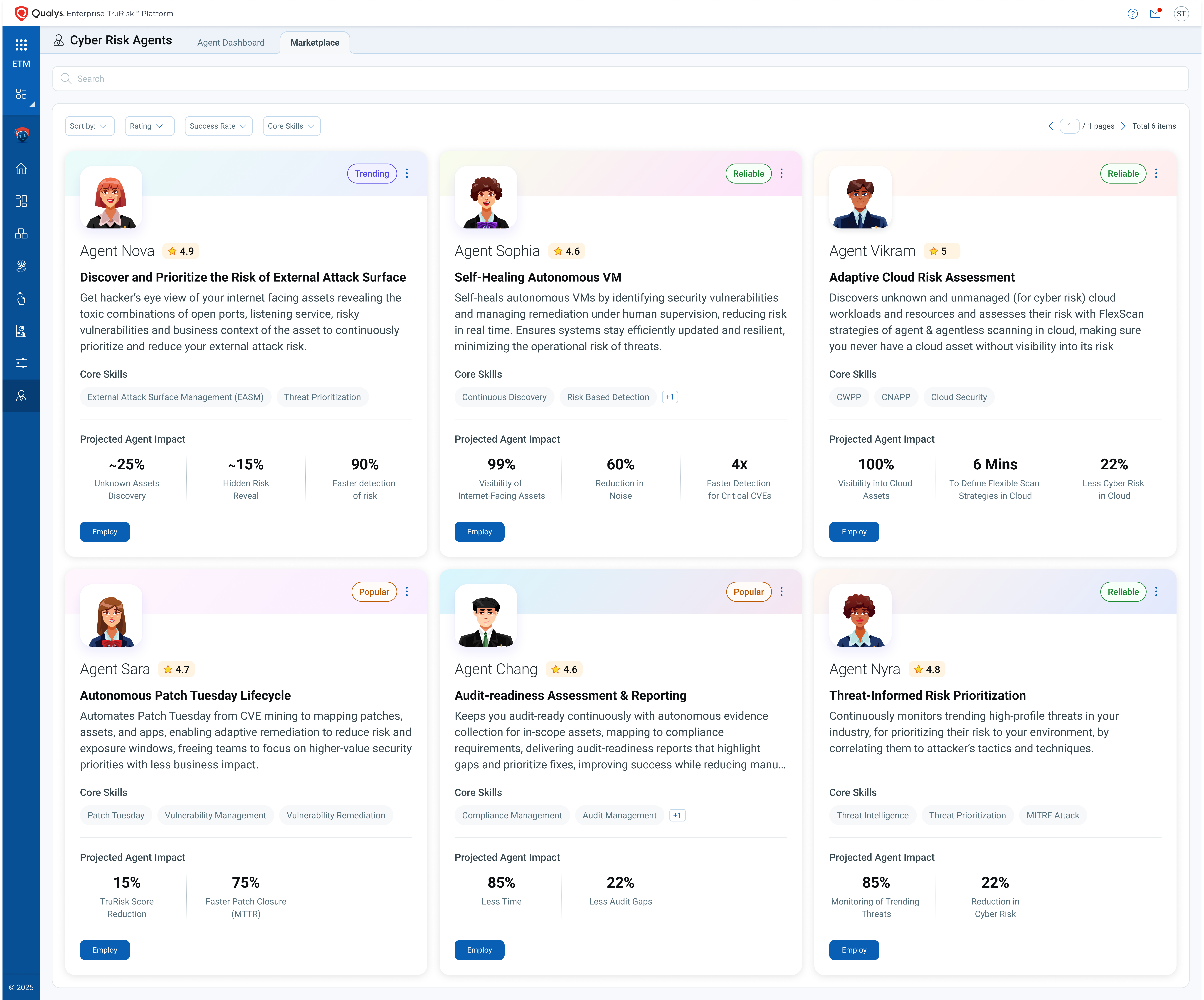
Through the Qualys Agentic AI marketplace, organizations can employ the pre-built Cyber Risk Agents as their skilled digital workforce tailored to address specific use cases. They can further create custom Cyber Risk Agents with an intuitive no-code builder to autonomously deliver specialized outcomes. These agents empower decision-making across all levels—whether tackling operational challenges in real time or delivering insightful reports for board-level briefings. By transforming fragmented data into actionable intelligence, Agentic AI strengthens security operations and drives efficient risk management.
Cyber Risk Assistant
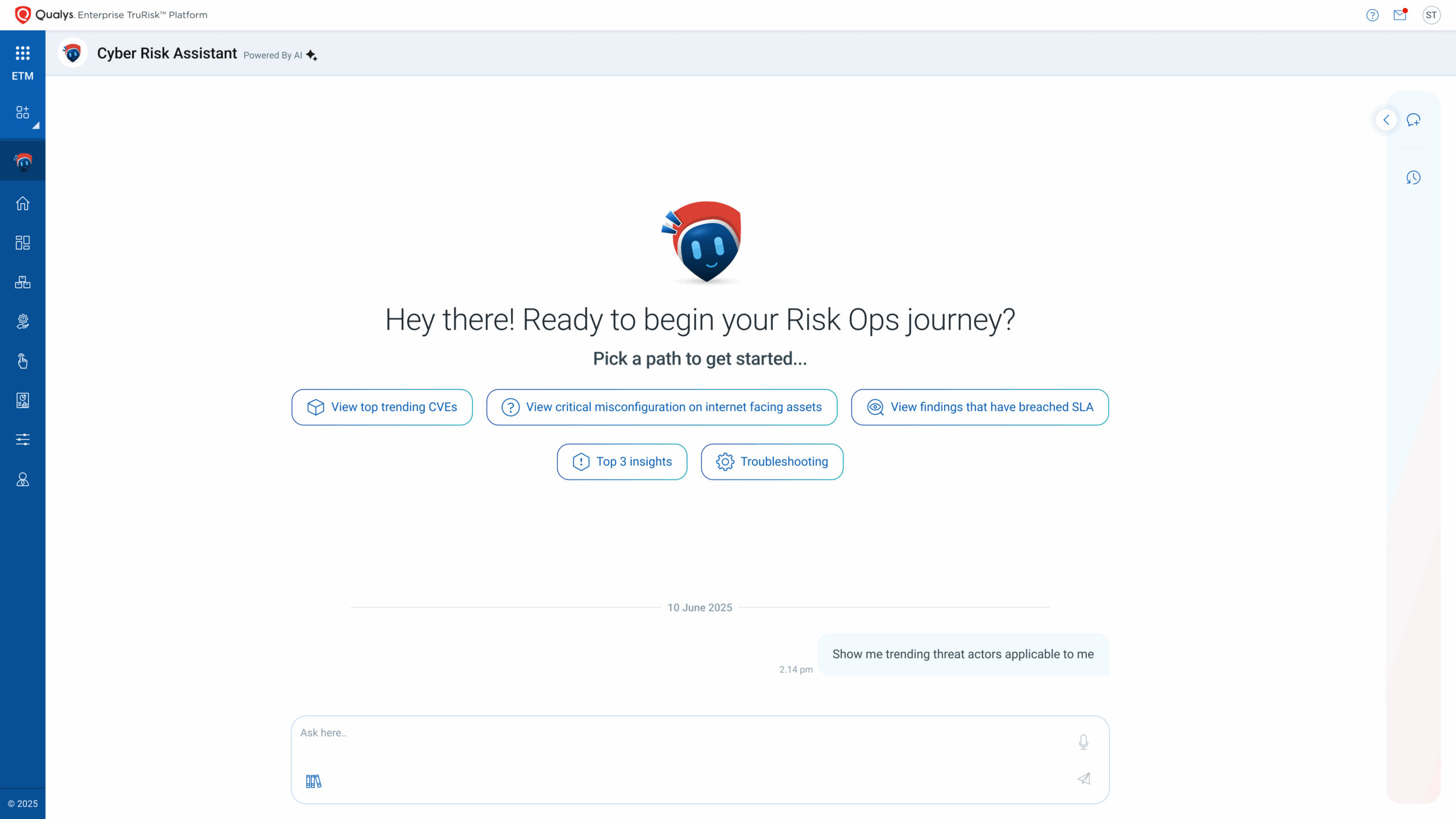
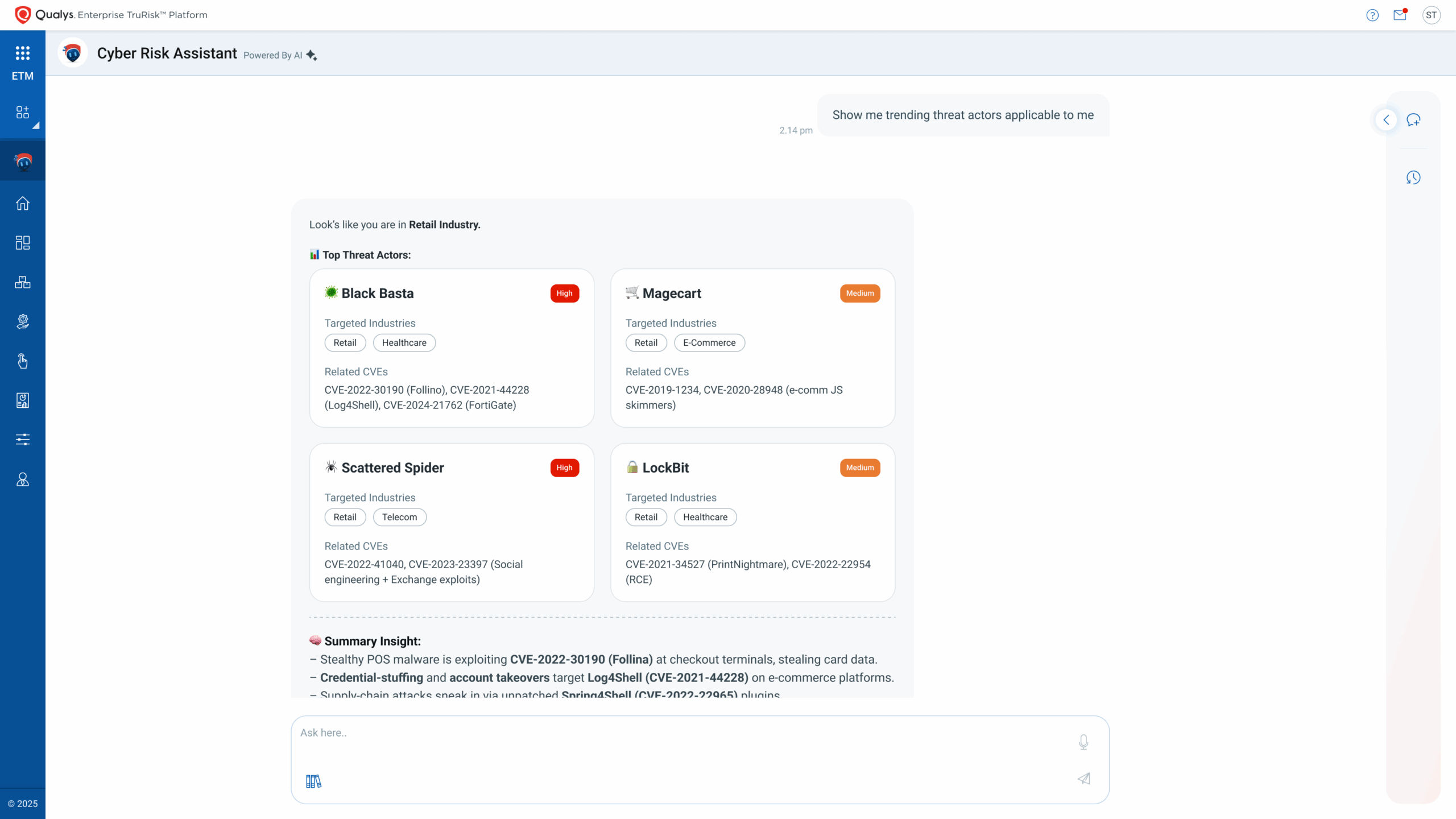
The prompt-driven Cyber Risk Assistant democratizes access to diverse security data by helping users navigate and evaluate their risk posture with a natural-language query. It helps with analyzing exposures, applying threat intelligence, and then, factoring in your unique environment, to deliver tailored insights, turning data into informed action. Whether you’re presenting to the board or making urgent operational decisions, the assistant can help you quickly surface the information you need and then introduce you to a Cyber Risk Agent, if you opt for a more hands-off autonomous experience.
Register for our webinar on September 9 to learn how to modernize your cyber risk management with Agentic AI.
Key Benefits of Qualys Agentic AI
By harnessing Agentic AI, organizations can achieve measurable improvements across their security operations:
- Democratized Data Access: Streamline the exploration of fragmented security data, empowering the entire security team to transform curiosity into actionable insights to reduce risks.
- Intelligent Decision Support: Access business impact-driven analytics that transform fragmented data into ranked, actionable insights.
- Enhanced Productivity: Drive productivity through autonomous risk reduction with human oversight. By uniting investigation, decision, and action into a seamless process, reduce MTTR significantly so the security team can focus on strategic, higher-value initiatives.
Use Cases for Agentic AI
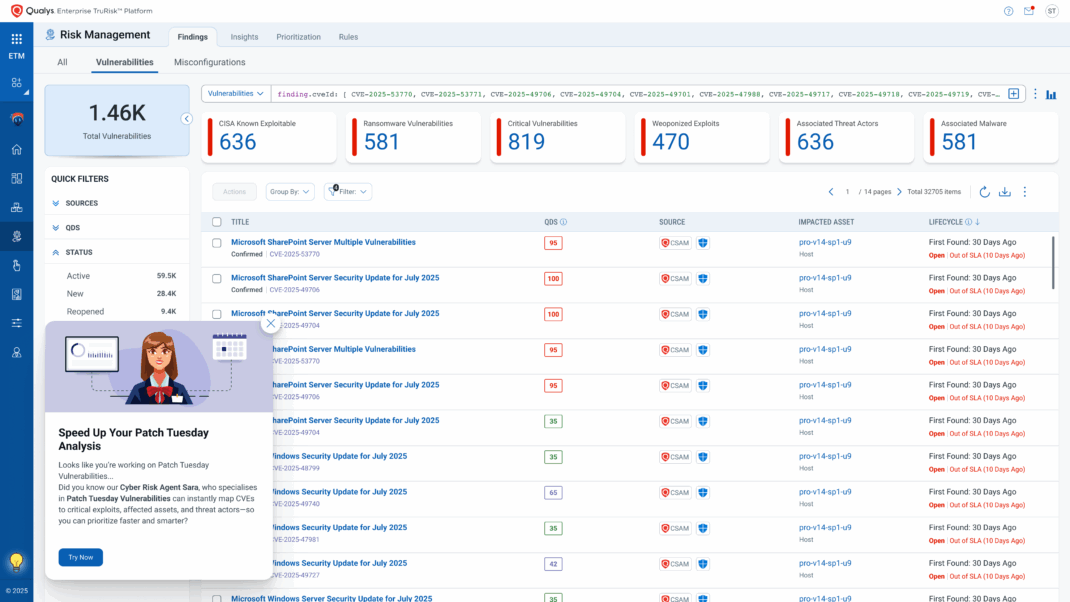
There are any number of areas where agentic AI can help security teams shift from tactical responders to strategic orchestrators. Here are just a few:
Agent Nova: Discover and Prioritize the Risk of External Attack Surface

Security teams today not only face an ever-increasing external attack surface, but the average organization is unaware of up to 25% of their internet-facing assets. With the Qualys Agent Nova for External Risk Discovery and Hacker’s-Eye Prioritization, they can now get visibility into their internet-facing assets without manual prompts or dashboard digging.
Agent Nova continuously identifies newly discovered internet-facing assets and exposures across the entire organizational footprint. It prioritizes full vulnerability scans based on risky open ports, EoL/EoS software, or potential vulnerabilities, correlating findings with threat intelligence tailored specifically to the organization’s industry and environment. Additionally, Agent Nova generates comprehensive “Hacker’s-Eye View” reports that reveal exactly what attackers would see and target.
Agent Vikram: Adaptive Cloud Risk Assessment
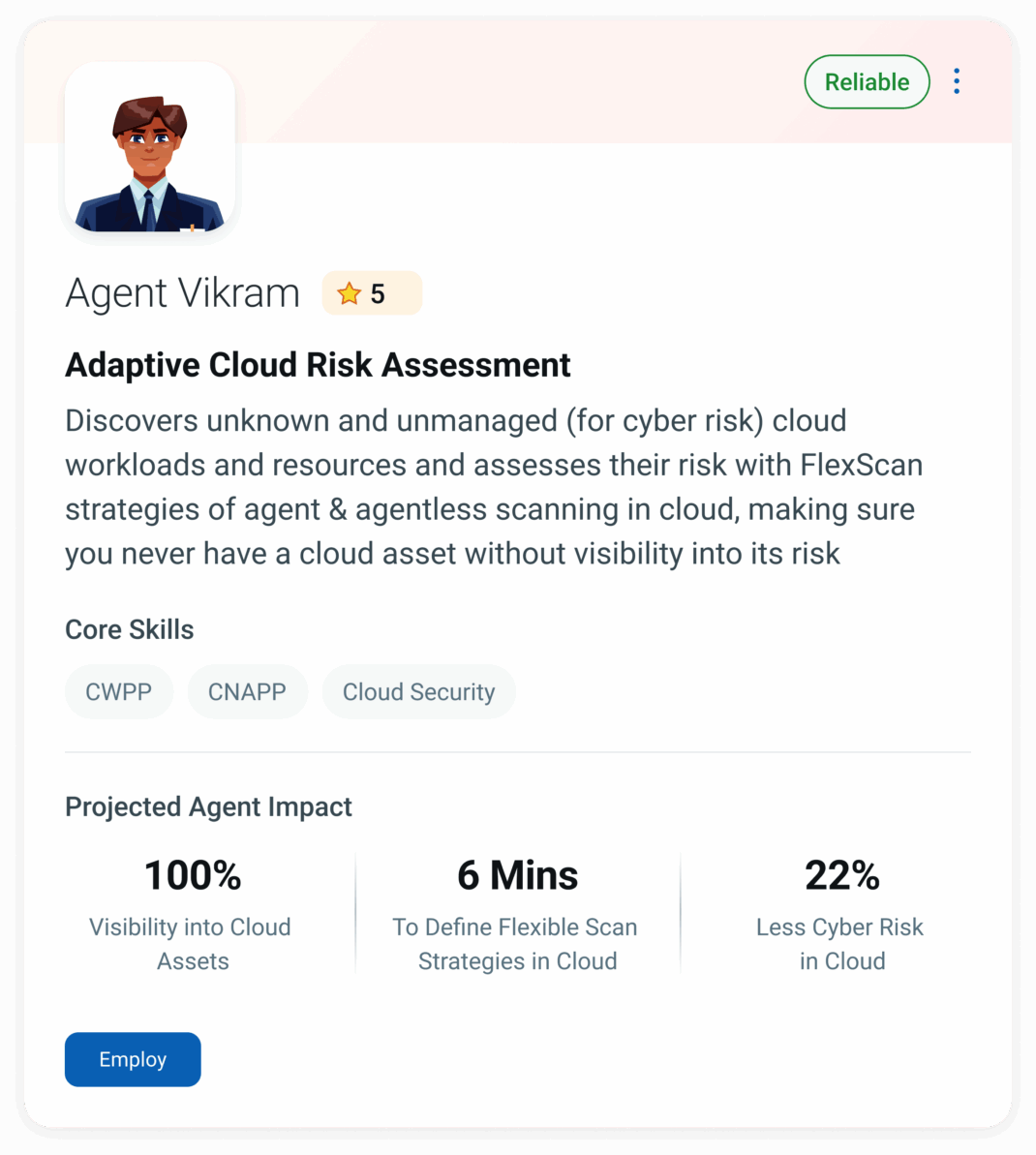
In today’s sprawling, fast‑changing multi‑cloud environments, visibility is never complete. In fact, Qualys’ latest Cloud Threat Research found that more than 30% of cloud VMs across AWS, Azure, and GCP were running with high or critical vulnerabilities—many of them in assets that weren’t even being scanned. These blind spots leave organizations exposed to silent but serious risks.
With Agent Vikram for cloud scanning, those gaps are closed automatically. The agent doesn’t just discover unmonitored assets—it autonomously determines and applies the right scan method for each workload: API‑based for connected instances, agent‑based for persistent VMs, snapshot‑based for stopped or ephemeral workloads, and cloud perimeter scanning for internet‑facing assets where traditional methods can’t reach—all without human intervention. With agentic AI powering every scan, cloud blind spots aren’t just identified—they’re eliminated, giving teams continuous, unified visibility and control across AWS, Azure, and GCP.
Agent Chang: Audit-readiness Assessment & Reporting
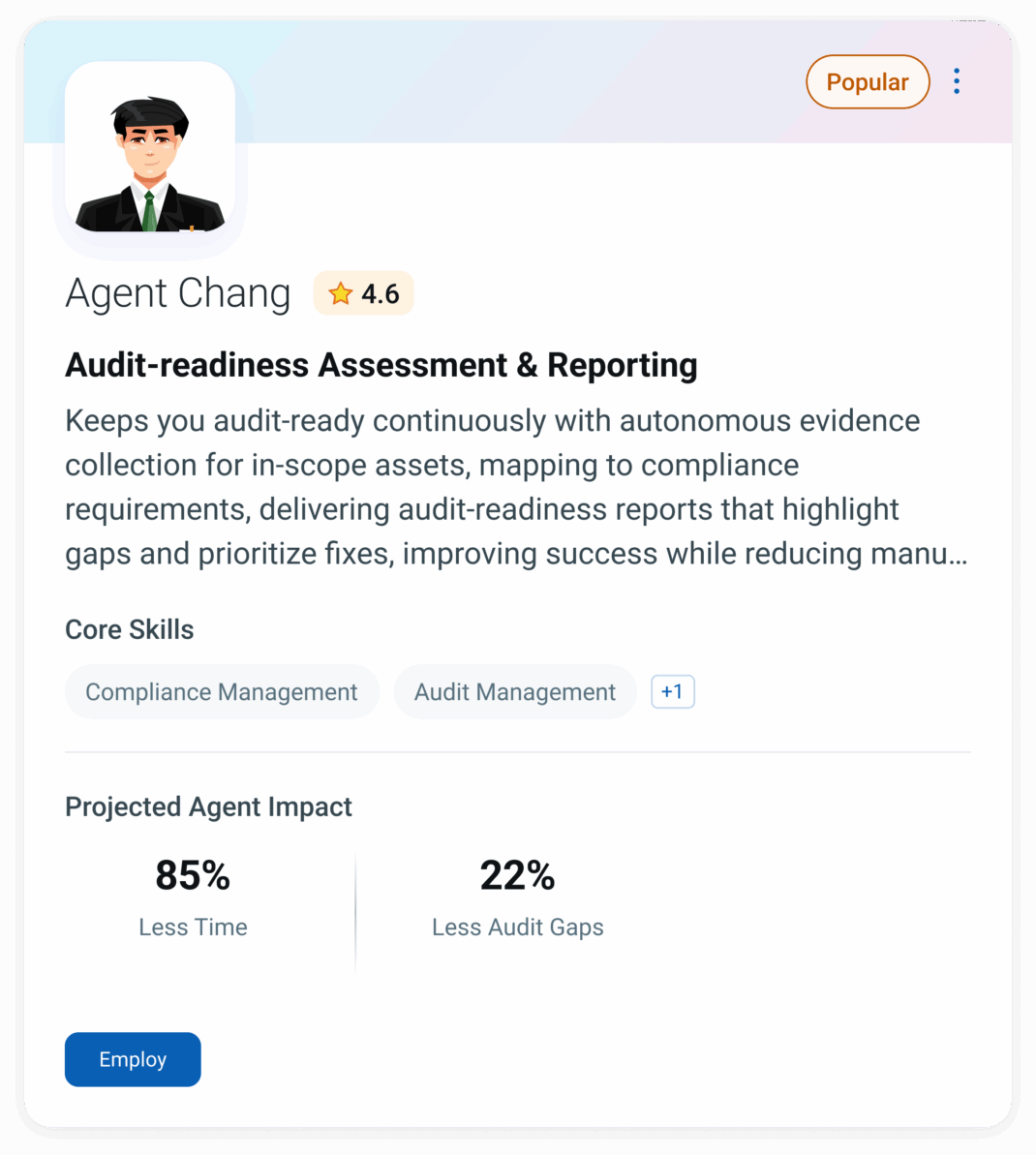
Staying audit ready is more important than ever; without automation, it’s a significant challenge. According to Coalfire’s 2023 Compliance Report, organizations can spend between 10,000 to 20,000 hours per audit, with nearly 50% of compliance failures stemming from human error.
Agent Chang in Qualys Policy Audit automates continuous evidence collection and audit-ready reporting across all in-scope assets and environments. It seamlessly maps gathered evidence to relevant compliance frameworks like ISO, NIST, PCI-DSS, and FedRAMP in real time, ensuring everything is audit-ready, timestamped, and contextualized. By prioritizing control failures that offer the greatest impact on audit readiness scores, Agent Chang helps teams focus remediation efforts effectively. It delivers dynamic dashboards for assessing compliance posture by business unit or framework, provides comprehensive audit readiness reports, and enables users to quickly retrieve focused insights on audit gaps and prioritize them for remediation. With Agent Chang, audit preparation becomes proactive and data-driven—minimizing risks, improving operational focus, streamlining audit operations, and weaving audit readiness effortlessly into daily business processes. This empowers organizations to maintain continuous audit readiness, ensuring they are always prepared for audits without last-minute stress or surprises.
Agent Nyra: Threat-informed Risk Prioritization
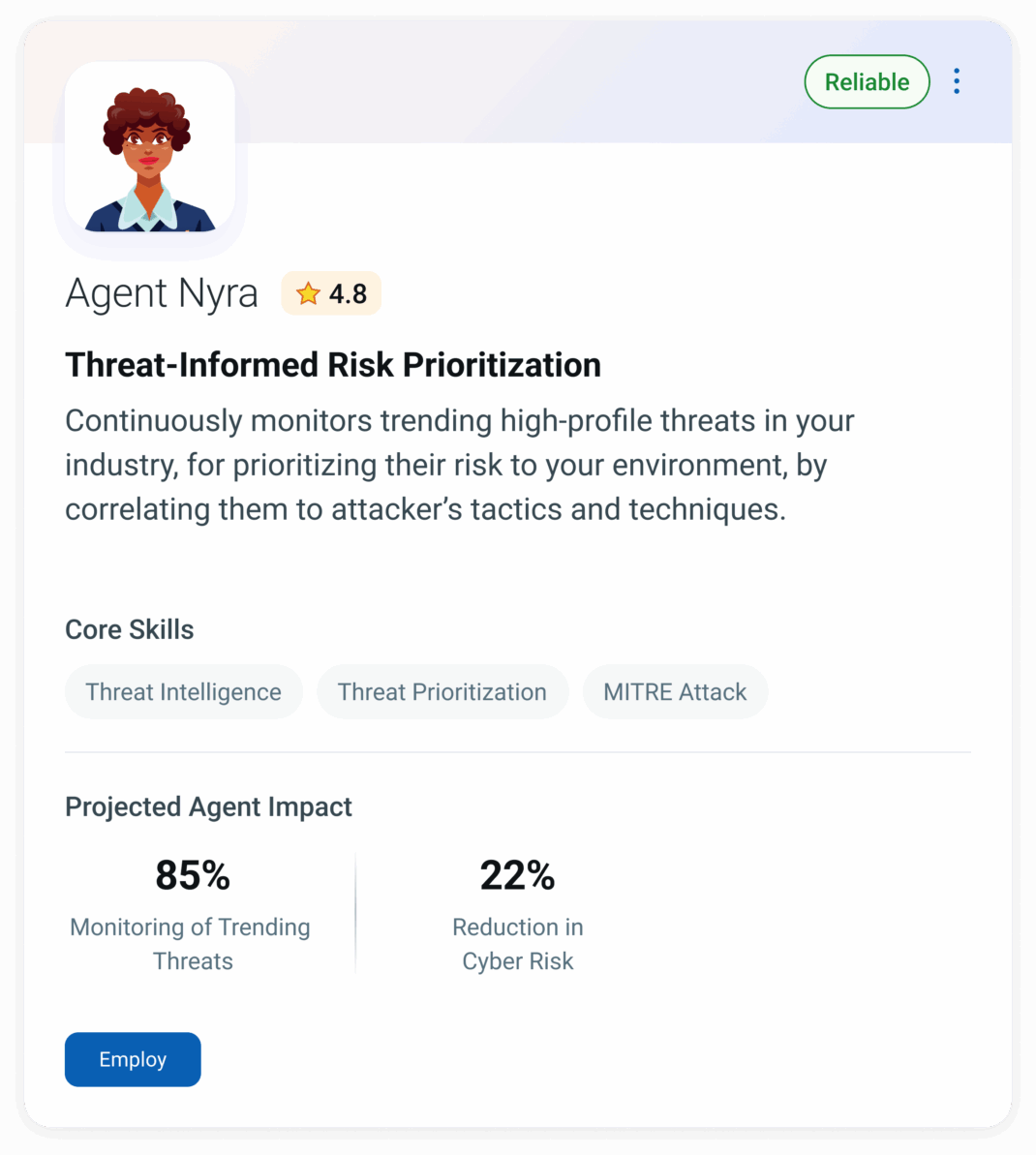
Security teams face an overwhelming mix of challenges: a surge in sophisticated attack vectors, enormous volumes of threat data generated across various systems, disconnected tool ecosystems that slow down remediation efforts, a constrained staff managing a constantly growing number of responsibilities, and navigating debilitating chokepoints. The result? Teams often struggle to focus on what matters most, leaving critical risks open for exploitation.
With Agent Nyra for monitoring adversaries and threat intelligence, defenders can rely on the autonomous agent to keep track of the real-time adversary behavior and threat intelligence that matters most to their unique industry and environment. The agent then alerts them to threats they need to be aware of and can even initiate playbooks for patching or mitigation actions based on that intelligence.
Agent Sara: Autonomous Patch Tuesday Lifecycle

IT teams are diligently deploying Patch Tuesday patches, monitoring patch failures, re-running jobs, fixing what failed, and automating their patching tasks. Still, we often see that around 20% of Microsoft Patch Tuesday (MSPT) vulnerabilities remain open for more than 30 days.
The reason is that the process is never smooth; it comes with its own challenges, such as:
- Prioritization: Identifying and prioritizing vulnerabilities already being exploited in the wild (CISA KEVs) or linked to ransomware. These often come with strict SLAs (less than a week) and can cause delays.
- Patch SLA violations: Manual methods of identifying impacted assets, deploying patches, and verifying success frequently lead to missed SLAs.
- Service disruption risks: Patches sometimes can’t be deployed because they might cause downtime or impact critical services.
These issues often lead to slower MTTRs, and many MSPT vulnerabilities remain unaddressed.
Agent Sara not only detects MSPT vulnerabilities, it also creates a comprehensive Risk Elimination Plan with actionable insights for the IT team. It automatically prioritizes vulnerabilities listed in the CISA KEV catalog, those with public exploits, active weaponization, or links to ransomware, and identifies the right patches to deploy, ensuring SLAs are met and assets remain secure and compliant with PCI DSS, CIS, and NCSC patch timelines.
It goes beyond regular patching. In scenarios where patches can’t be deployed immediately due to the risk of downtime, Qualys Agentic AI identifies the right mitigations and applies them to make vulnerabilities unexploitable until patches can be safely deployed.
This makes IT teams’ lives much easier as the agent, without any human intervention, now manages the entire Patch Tuesday process end-to-end.
Agent Sophia: Self-Healing Autonomous VM

The Self-Healing Autonomous Vulnerability Management agent is designed to overcome the core challenge of current scan-and-report means. Agent Sophia uses a multi-agent AI system to build and maintain vulnerability management for the entire IT environment. Specialized agents autonomously discover vulnerabilities, prioritize them based on real-time business context, and execute the full remediation lifecycle with a central human-on-the-loop control plane. This ensures every action is explainable, auditable, and ruled by configurable safety policies, allowing security teams to focus on strategic risk reduction.
According to the Qualys Threat Research Unit, 5% CISA Known Exploited Vulnerabilities (KEVs) remain unpatched for over 90 days. This creates a critical window of exposure, especially when the median time for threat actors to weaponize these high-risk vulnerabilities is just 5.5 days. Qualys customers already using advanced prioritization through Qualys TruRisk routinely close out critical flaws before they even land in CISA’s KEV catalog. The next leap? A self-healing, fully autonomous VM that doesn’t just win the race against exploitation—it starts and finishes before the starting gun ever fires. In this high-stakes environment, an autonomous platform is transformative. The self-healing capability is far more than a simple script runner; it’s an engineered system of AI agents executing a rigorous workflow that mirrors and enhances enterprise-grade best practices for vulnerability management, closing the gap between detection and remediation at machine speed.
Conclusion
Agentic AI redefines risk management by making security operations smarter, faster, and more cost-effective. With autonomous workflows that reduce complexity and accelerate processes, you can confidently secure your expanding attack surface while optimizing resources. This innovative approach empowers teams to achieve measurable improvements, shifting focus from reactive measures to proactive security strategies.
With Agentic AI, the future of autonomous cybersecurity is here.
Be among the first to experience the future of AI-powered risk management; Sign up for a preview (available mid-September).